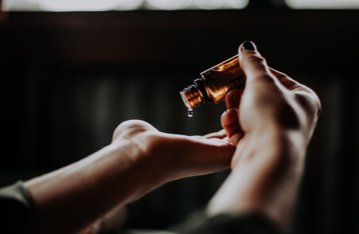 ARRRRRR, artificial fragrances!
ARRRRRR, artificial fragrances!
The other day I drove my son’s car and within a few minutes I pulled over and searched the vehicle high and low. I was a woman possessed searching for a smell that was so treacherous that I simply had to get rid of it. Like a specially trained K-9 narcotics sniffer dog I searched and found the small piece of cardboard that I had been looking for, walked to a nearby garbage bin and threw the illicit little scented cardboard tree away knowing full well that I’d have to explain myself later.
Hence this article 🙂
The smell however had been so overpowering and nauseating that I had to keep his windows open all day just to clear out the residues of the fragrance.
One of my sons’ lovely friends had generously bought him the air freshener tree as a “car warming present” a small gift to celebrate his licence and his new set of wheels but I’ll have to sweetly tell him that he needn’t have and share with him the health pit falls of fragrances.
Now I know I’m not alone in detesting these kinds of artificial fragrances, many of us find the smells horrid. Most of us also have a sense they cause more harm than good. Here’s what The Natural Resources Defence Council (NRDC) an international environmental organization says in their study called, “Clearing the Air: Hidden Hazards of Air Fresheners” in which they found 86% of air fresheners tested contained dangerous phthalates.
Here’s their summary on the impact of car freshener ingredients:
- Most phthalates are well known to interfere with production of the male hormone testosterone and have been associated with reproductive abnormalities.”
- Acetone—is a blood, heart, gastrointestinal, liver, kidney, skin, respiratory, brain and nervous system toxin. It can damage just about any part of your body and have a wide range of adverse effects.
- Butane and Isobutane—Yes, lighter fluid. It a serious toxin to our brain and nervous system.
- Liquified Petroleum Gas and Petroleum Distillate—It is fairly obvious why we wouldn’t want to add this to our air supply.
- Propane—a cardiovascular and blood toxin; liver, kidney, respiratory, skin, and nervous system toxin known to be extremely dangerous and that’s why we operate propane barbecues outdoors yet we’re spraying this stuff into our indoor air.
- Perfume– This single ingredient contains up to 400 different toxic ingredients, 95 percent of which are derived from petroleum products and are linked to a whole host of serious health conditions ranging from headaches and dizziness to depression and behavioral changes.
- Benzene—known to cause leukemia in humans.
- Formaldehyde–linked to cancers of the upper airways.
Want fresh air?
Open a window I say!! =)
 What Is Fragrance?
What Is Fragrance?
More than 95 percent of the chemicals in synthetic fragrances are derived from petrochemicals. These chemicals include: benzene derivatives, aldehydes, phthalates, and a slew of other known toxins that are capable of causing cancer, birth defects, nervous-system disorders and allergies—some of which are cited on the EPA’s hazardous waste list.
“Fragrance” is a cover-up name for phthalates – a very well documented family of chemicals now thought to contribute to a number of hormone imbalances, including thyroid problems in both men and women as well as early puberty in girls.
Phthalates – these chemicals are in pretty much in every product imaginable, from household cleaners to cosmetics to personal care products and perfume. This chemical acts as a binding agent and is also used to make plastics more flexible. Phthalates are used as plastic softeners, anti-foaming agents in aerosols, in vinyl found in children’s toys, automobiles, paints, pesticides, and in cosmetics and fragrances.
NOTE: We often don’t see ‘phthalates’ on product labels; instead we’ll see ‘fragrance’ or ‘perfume’.
Things We Now Know About Fragrance And Phthalates:
- Phthalates have been demonstrated to cause “death-inducing signaling” in testicular cells, making them die earlier then they should. Reducing sperm concentration and motility in men.
- Phthalates were dubbed “obesogen” in 2006 by Felix Grün and Bruce Blumberg of the University of California, Irvine who showed that they affect genes that uptake fat and grow fat cells.
- A 2017 study found collected blood samples of pregnant women and found that as phthalate blood levels increased, leptin levels decreased. Leptin is a hormone that lets us know we are full, and decreased levels can result in overeating.
- Phthalates have been linked as a contributing factor for some cases of obesity and type 2 diabetes.
- Phthalates are xenoestrogens (external estrogen-mimicking compounds) and have also been linked to endometriosis and breast cancer
- As xenoestrogens phthalates have been shown to create hormone imbalances, including thyroid problems in both men and women as well as early puberty in girls.
- Phthalates have been linked to abnormal reproductive system development in baby boys.
- The Department of Medical Endocrinology of the University of Copenhagen in Denmark found that phthalates can also severely disrupt the immune system.
- Phthalates have been linked to skin issues, such as contact dermatitis, increased allergies and asthma and even changes in the brains and behaviors of infants and children.
- Lastly, they’ve been linked to ADHD, low IQ, developmental issues, behavioural issues and autism spectrum disorders.
A study by researchers, from the University of California, Berkeley, and Clinica de Salud del Valle de Salinas, compared body chemical levels with usage of chemical-containing products. The researchers noted that adult women, but most especially female teenagers are at a greater risk of exposure as they are the largest group of cosmetic users and personal care items.
 “Because women are the primary consumers of many personal care products, they may be disproportionately exposed to these chemicals,” said study lead author Kim Harley, associate director of the UC Berkeley Centre for Environmental Research and Children’s Health.
“Because women are the primary consumers of many personal care products, they may be disproportionately exposed to these chemicals,” said study lead author Kim Harley, associate director of the UC Berkeley Centre for Environmental Research and Children’s Health.
“Teen girls may be at particular risk since it’s a time of rapid reproductive development, and research has suggested that they use more personal care products per day than the average adult woman.”
The study published in the journal Environmental Health Perspectives reviewed 100 teenagers who were given personal care products that were free of typical chemicals found in cosmetics and personal care products, phthalates, parabens, triclosan and oxybenzone.
These chemicals are ubiquitous in everything from cosmetics to hair products, soaps and sunscreens. Previous studies had already shown interference from exposure to these chemicals in animals, those exposed presenting with endocrine issues.
The researchers took urine samples before the products were removed from the participant’s exposure. Then they gave the teenagers the low-chemical products to replace the chemical ones and tested their urine samples again, three days later.
The results were substantial. The report noted:
- Metabolites of diethyl phthalate, commonly used in fragrances, decreased 27 percent by the end of the trial period.
- Methyl and propyl parabens, used as preservatives in cosmetics, dropped 44 and 45 percent respectively.
- Both triclosan, found in antibacterial soaps and some brands of toothpaste, and benzophenone-3 (BP-3), found in some sunscreens under the name oxybenzone, fell 36 percent.
How To Avoid Fragrance And Phthalates?
Removing the chemical burden, you place on your body every day is vitally important in minimizing the detrimental effects that are now scientifically proven to harm our body and that of our children.
 The simplest way you can minimize this burden is by:
The simplest way you can minimize this burden is by:
- Switching to certified organic and committing to, as much as humanly possible, a chemical free home and life.
- Avoid personal care products that contain phthalates (or listed as “Fragrance Added”) You can find phthalate free personal care products with the EWG Skin Deep Database.
- There are so many wonderful aromatherapy products available today, take a look at these and let your senses be delighted.
- Avoid plastic food containers
- Plastic kids’ toys
- Plastic wrap made from PVC (recycling label #3)
Here’s Environmental Defence’s “toxic ten,” a quick list of ingredients to avoid:
- 1,4-Dioxane
- Artificial Musks
- Coal Tar Derived Colours
- Bha And Bht
- Formaldehyde-Releasing Agents
- Petrolatum
- Parabens
- Phthalates
- Silicone Chemicals
- Triclosan
“Fragrance” is at the top of my “no-no” list.
If a manufacturer isn’t willing to list ALL of a product’s ingredients on its label, that’s a deal breaker for me.
I hope it is for you, too.
Consider shopping at your local health food store for organic and/or natural options.
. . . . .
 Yours in Health,
Yours in Health,
Jennifer Barham-Floreani
(Bach. Chiropractic, Bach. App Clinical Science
Registered internationally, no longer practicing as a chiropractor in Australia.)
. . . . .
Resources
Natural Resources Defense Council Sept 2007
https://www.nrdc.org/sites/default/files/airfresheners.pdfHuman studies have reported that exposure to phthalates or bisphenol A (BPA) may affect thyroid signaling
https://www.ncbi.nlm.nih.gov/pubmed/21749963
Estrogen-like endocrine disrupting chemicals affecting puberty in humans
https://www.ncbi.nlm.nih.gov/pubmed/19478717
Toxic Load https://www.ncbi.nlm.nih.gov/pmc/articles/PMC3249606/#R7
Phthalate metabolites related to infertile biomarkers and infertility
https://www.ncbi.nlm.nih.gov/pubmed/28810198
Mono-2-ethyhexyl phthalate (MEHP), an environmental xenoestrogen, on the development of cervical cancers
https://www.ncbi.nlm.nih.gov/pubmed/29382535
https://www.ncbi.nlm.nih.gov/pubmed/29382535
Phthalates and type 1 diabetes: is there any link?
https://www.ncbi.nlm.nih.gov/pubmed/29680886
Potential influence of the phthalates on normal liver function and cardiometabolic risk in males.
https://www.ncbi.nlm.nih.gov/pubmed/29234897
https://www.ncbi.nlm.nih.gov/pubmed/29234897
Consumer product exposures associated with urinary phthalate levels in pregnant women
https://www.ncbi.nlm.nih.gov/pmc/articles/PMC3439834/
Association between prenatal bisphenol A and phthalate exposures and fetal metabolic related biomarkers: The Hokkaido study on Environment and Children’s Health. https://www.ncbi.nlm.nih.gov/pubmed/29223775
Concentrations of parabens in human breast tumours. Darbre PD1, Aljarrah A, Miller WR, Coldham NG, Sauer MJ, Pope GS. J Appl Toxicol. 2004 Jan-Feb;24(1):5-13.
Phthalates and Cumulative Risk Assessment: The Tasks Ahead (2008) Committee on The Helth Risk of Phthalates Board on Enviromental Sutdies and Toxicology National Reearch council of the national Academies
Report to the U.S. Consumer Product Safety Commission by the CHRONIC HAZARD ADVISORY PANEL ON PHTHALATES AND PHTHALATE ALTERNATIVES July 2014 U.S.
Consumer Product Safety Commission Directorate for Health Sciences Bethesda, MD 20814
Recent Advances on Endocrine Disrupting Effects of UV Filters Jiaying Wang,1,2 Liumeng Pan,1 Shenggan Wu,3 Liping Lu,1 Yiwen Xu,1 Yanye Zhu,1 Ming Guo,4 and Shulin Zhuang1,2,5,* Huixiao Hong, Academic Editor Int J Environ Res Public Health 2016 Aug; 13(8): 782.
Reducing Phthalate, Paraben, and Phenol Exposure from Personal Care Products in Adolescent Girls: Findings from the HERMOSA Intervention Study Kim G. Harley,1 Katherine Kogut,1 Daniel S. Madrigal,1 Maritza Cardenas,1 Irene A. Vera,1 Gonzalo Meza-Alfaro,1 Jianwen She,2 Qi Gavin,2 Rana Zahedi,2 Asa Bradman,1 Brenda Eskenazi,1 and Kimberly L. Parra3 Environmental Health Perspectives, Oct 2016, Vol 124, Iss 10





